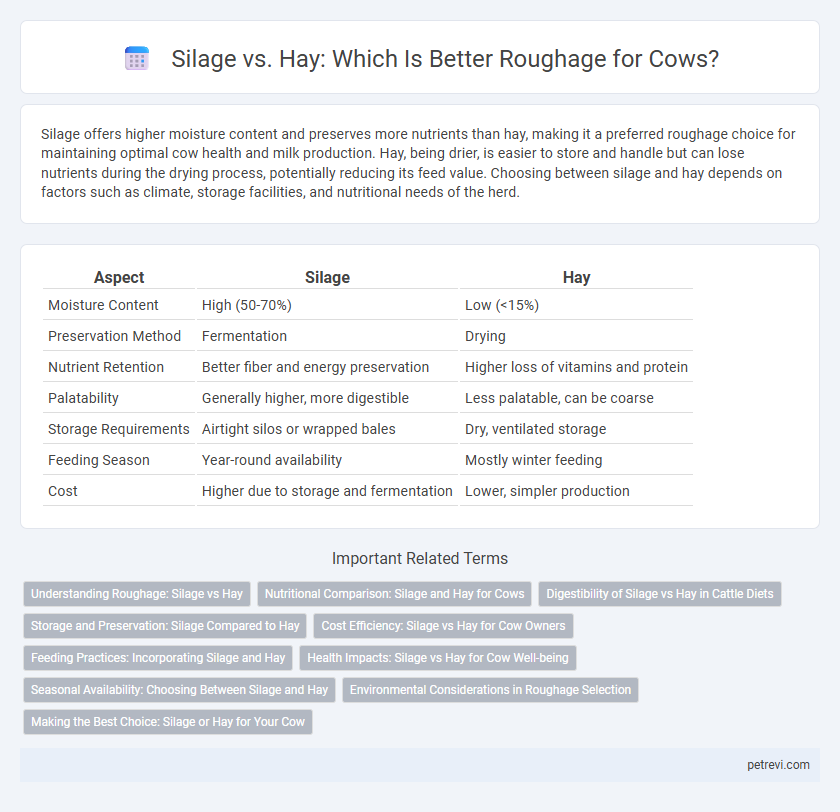Silage offers higher moisture content and preserves more nutrients than hay, making it a preferred roughage choice for maintaining optimal cow health and milk production. Hay, being drier, is easier to store and handle but can lose nutrients during the drying process, potentially reducing its feed value. Choosing between silage and hay depends on factors such as climate, storage facilities, and nutritional needs of the herd.
Table of Comparison
| Aspect | Silage | Hay |
|---|---|---|
| Moisture Content | High (50-70%) | Low (<15%) |
| Preservation Method | Fermentation | Drying |
| Nutrient Retention | Better fiber and energy preservation | Higher loss of vitamins and protein |
| Palatability | Generally higher, more digestible | Less palatable, can be coarse |
| Storage Requirements | Airtight silos or wrapped bales | Dry, ventilated storage |
| Feeding Season | Year-round availability | Mostly winter feeding |
| Cost | Higher due to storage and fermentation | Lower, simpler production |
Understanding Roughage: Silage vs Hay
Silage, fermented and stored under anaerobic conditions, provides cows with high-moisture roughage rich in digestible nutrients and energy, promoting better intake during winter months. Hay, dried and cured forage, offers a stable, low-moisture feed option high in fiber but lower in readily fermentable carbohydrates compared to silage. Choosing between silage and hay depends on factors like forage availability, storage capacity, and nutritional requirements to optimize cow health and milk production.
Nutritional Comparison: Silage and Hay for Cows
Silage offers higher moisture content and better preservation of nutrients like protein and energy compared to hay, which tends to lose nutrients during drying. Silage's fermentation process enhances digestibility and maintains vitamins such as A and E, whereas hay typically contains lower digestible fiber levels and may have reduced vitamin content. For optimal cow nutrition, silage provides a more energy-dense and palatable roughage source, while hay serves as a useful dry forage option in certain feeding regimes.
Digestibility of Silage vs Hay in Cattle Diets
Silage typically offers higher digestibility than hay in cattle diets due to its fermentation process, which preserves more nutrients and enhances fiber breakdown. Studies show that cattle fed silage exhibit improved nutrient absorption and energy availability compared to those consuming dry hay, resulting in better weight gain and milk production. The moisture content in silage also supports microbial activity in the rumen, further optimizing fiber digestion and overall feed efficiency.
Storage and Preservation: Silage Compared to Hay
Silage offers superior storage and preservation benefits compared to hay due to its high moisture content and anaerobic fermentation process, which minimizes nutrient loss and spoilage. Unlike hay, which requires dry conditions and can deteriorate from moisture or mold during storage, silage is sealed in airtight containers or silos, maintaining quality for extended periods. This controlled environment enhances feed stability and nutritional value, making silage a more reliable roughage option for cows.
Cost Efficiency: Silage vs Hay for Cow Owners
Silage generally offers greater cost efficiency for cow owners due to its higher nutritional value per unit of weight, which reduces the amount of feed required and minimizes waste compared to hay. While the initial investment in silage production can be higher because of specialized storage equipment like silos or bunker systems, long-term savings are realized through better feed conversion and lower spoilage rates. Hay production involves lower upfront costs but often results in increased feed loss and lower digestibility, leading to higher overall feeding expenses for maintaining cow health and productivity.
Feeding Practices: Incorporating Silage and Hay
Feeding practices for cows often integrate both silage and hay to optimize nutritional value and digestive health. Silage, with its high moisture content and fermentative preservation, provides a rich energy source essential during lactation and growth periods, while hay contributes fiber crucial for rumen function and overall digestive stability. Balancing these roughages ensures consistent feed intake, maximizes nutrient absorption, and supports sustainable milk production and weight gain in cattle.
Health Impacts: Silage vs Hay for Cow Well-being
Silage provides higher moisture content and better preservation of nutrients compared to hay, promoting improved digestion and overall gut health in cows. Hay, with its lower moisture, reduces the risk of acidosis but may lead to decreased intake of vital nutrients. Proper selection between silage and hay significantly affects cow well-being by balancing fiber quality, nutrient availability, and digestive stability.
Seasonal Availability: Choosing Between Silage and Hay
Silage offers year-round availability due to its preservation through fermentation, making it a reliable roughage during wet or cold seasons when fresh forage is scarce. Hay depends heavily on favorable dry weather for harvesting and storage, which limits its availability during rainy seasons or extended wet periods. Selecting between silage and hay involves evaluating local climate patterns to ensure consistent nutritional supply for cows throughout seasonal variations.
Environmental Considerations in Roughage Selection
Silage and hay differ significantly in their environmental impact as roughage options for cows, with silage typically requiring more energy-intensive storage and fermentation processes that can increase greenhouse gas emissions. Hay production often demands more land and water resources due to extended drying periods, which can lead to soil degradation and water depletion in arid regions. Selecting roughage involves balancing these environmental considerations with local climate, resource availability, and farm management practices to optimize sustainability in cattle nutrition.
Making the Best Choice: Silage or Hay for Your Cow
Choosing between silage and hay for cow roughage depends on nutritional needs and storage conditions, as silage typically offers higher moisture content and better preservation of nutrients through fermentation, boosting energy and digestibility. Hay provides lower moisture and is advantageous for long-term storage and ease of handling, with optimal fiber content benefiting rumen health. Farmers should evaluate forage quality, climate, and feeding objectives to determine the ideal roughage that supports milk production and weight gain effectively.
Silage vs Hay for Cow roughage Infographic

 petrevi.com
petrevi.com